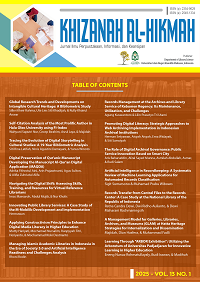Self-Citation Analysis of the Most Prolific Author in Halu Oleo University using Fi-Index
DOI:
https://doi.org/10.24252/v13i1a2Keywords:
Bibliometric, Fi-Index, H-Index, Self-CitationAbstract
This study aims to analyze the self-citation behavior of the ten most productive lecturers at Halu Oleo University using a bibliometric approach. Employing the Fi-Index method for self-citation analysis, the research followed three main stages: data collection, data processing, and data analysis. The data were obtained from the Scopus database, focusing on the top ten productive lecturers at the institution. Each lecturer's self-citation activity was measured using the Fi-Index formula, which compares the number of self-citations relative to their h-index. The findings revealed that all ten lecturers demonstrated self-citation patterns within a normal range. Muhammad Nurdin recorded the highest number of self-citations (867) with a Fi-Index score of 0.047572, followed by Maulidiyah (654, Fi-Index 0.043446), and others with similarly low Fi-Index scores ranging from 0.002096 to 0.043446. These values indicate that their self-citation practices do not exceed what is typically considered acceptable relative to their publication impact. The study concludes that the Fi-Index is a practical tool for evaluating the proportionality of self-citations among academic authors. It is recommended that future research apply the Fi-Index more broadly to assess self-citation behaviors among researchers across institutions and disciplines, ensuring a balanced interpretation of scholarly influence.
Downloads
References
Amjad, T., Rehmat, Y., Daud, A., & Abbasi, R.A. (2020). Scientific impact of an author and role of self-citations. Scientometrics, 122(2), 915–932.https://doi.org/10.1007/s11192-019-03334-2
Ataie-Ashtiani, B. (2016). Recruitment Processes in Academia: Did the Emperor Have Any Clothes? In Science and Engineering Ethics (Vol. 22, Issue 5, pp. 1565–1568). Springer Netherlands.https://doi.org/10.1007/s11948-015-9711-8
Beall, J. (2017). What I learned from predatory publishers. Biochemia Medica, 27(2), 273–278.https://doi.org/10.11613/BM.2017.029
Biagioli, M. (2016). biagioli 2016. Nature, 535(7611).https://doi.org/https://doi.org/10.1038/535201a
Bittermann, A., McNamara, D., Simonsmeier, B. A., & Schneider, M. (2023). The Landscape of Research on Prior Knowledge and Learning: a Bibliometric Analysis. In Educational Psychology Review (Vol. 35, Issue 2). Springer.https://doi.org/10.1007/s10648-023-09775-9
Cahyani, UE, Sari, DP, Ma'ruf, R., & Siregar, A. (2022). Bibliometric Analysis of Halal Tourism to Explore Determinants of Tourist Destination Competitiveness. Journal of Islamic Tourism, Halal Food, Islamic Traveling, and Creative Economy, 106(2), 2776–7434.https://doi.org/10.21274
Chorus, C., & Waltman, L. (2016). A large-scale analysis of impact factors biased journal self-citations. PLOS ONE, 11(8).https://doi.org/10.1371/journal.pone.0161021
Copiello, S. (2019). On the skewness of journal self-citations and publisher self-citations: Cues for discussion from a case study. Learned Publishing, 32(3), 249–258.https://doi.org/10.1002/leap.1235
Fiorillo, L. (2022). Fi-Index: A New Method to Evaluate Authors Hirsch-Index Reliability. Publishing Research Quarterly, 38(3), 465–474.https://doi.org/10.1007/s12109-022-09892-3
Fiorillo, L. (2024). Detecting the Impact of Academic Self-Citations: Fi-Score. Publishing Research Quarterly, 40(1), 70–79.https://doi.org/10.1007/s12109-024-09976-2
Fiorillo, L., & Cicciù, M. (2022). The Use of Fi-Index Tool to Assess Per-manuscript Self-citations. Publishing Research Quarterly, 38(4), 684–692.https://doi.org/10.1007/s12109-022-09920-2
Galvez, R.H. (2017). Assessing author self-citation as a mechanism of relevant knowledge diffusion. Scientometrics, 111(3), 1801–1812.https://doi.org/10.1007/s11192-017-2330-1
Huang, G., Fang, C.H., Lopez, S.A., Bhagat, N., Langer, P.D., & Eloy, J.A. (2015). Impact of fellowship training on research productivity in academic ophthalmology. Journal of Surgical Education, 72(3), 410–417.https://doi.org/10.1016/j.jsurg.2014.10.010
Kacem, A., Flatt, J. W., & Mayr, P. (2020). Tracking self-citations in academic publishing. In Scientometrics (Vol. 123, Issue 2, pp. 1157–1165). Springer Netherlands.https://doi.org/10.1007/s11192-020-03413-9
Liu, M.Y., Chien, T.W., & Chou, W. (2022). The Hirsch-index in self-citation rates with articles in Medicine (Baltimore): Bibliometric analysis of publications in two stages from 2018 to 2021. Medicine (United States), 101(45), E31609.https://doi.org/10.1097/MD.0000000000031609
Man, DWK, Tsang, WSF, Lu, EY, & Tsang, HWH (2019). Bibliometric study of research productivity in occupational therapy and physical therapy/physiotherapy in four Western countries and five Asian countries/regions. Australian Occupational Therapy Journal, 66(6), 690–699.https://doi.org/10.1111/1440-1630.12608
Marzi, G., Balzano, M., Caputo, A., & Pellegrini, M. M. (2024). Guidelines for Bibliometric-Systematic Literature Reviews: 10 steps to combine analysis, synthesis and theory development. International Journal of Management Reviews.https://doi.org/10.1111/ijmr.12381
McLeod, S. (2021). Should authors cite sources suggested by peer reviewers? Six antidotes for handling potentially coercive reviewer citation suggestions. In Learned Publishing (Vol. 34, Issue 2, pp. 282–286). John Wiley and Sons Inc.https://doi.org/10.1002/leap.1335
Mongeon, P., & Paul-Hus, A. (2016). The journal coverage of Web of Science and Scopus: a comparative analysis. Scientometrics, 106(1), 213–228.https://doi.org/10.1007/s11192-015-1765-5
Moral-Muñoz, J.A., Herrera-Viedma, E., Santisteban-Espejo, A., & Cobo, M.J. (2020). Software tools for conducting bibliometric analysis in science: An up-to-date review. In Professional de la Informacion (Vol. 29, Issue 1). El Professional de la Information.https://doi.org/10.3145/epi.2020.ene.03
Öztürk, O., Kocaman, R., & Kanbach, D. K. (2024). How to design bibliometric research: an overview and a framework proposal. Review of Managerial Science.https://doi.org/10.1007/s11846-024-00738-0
Pandita, R., & Singh, S. (2017). Self-citations, a prevalent trend across subject disciplines at the global level: an overview. Collection Building, 36(3), 115–126.https://doi.org/10.1108/CB-03-2017-0008
Salvador-Oliván, J. A., & Agustín-Lacruz, C. (2015). Correlación entre indicadores bibliométricos en review de web of science y scopus. Revista General de Information and Documentation, 25(2), 341–359.https://doi.org/10.5209/rev_RGID.2015.v25.n2.51241
Seeber, M., Cattaneo, M., Meoli, M., & Malighetti, P. (2019). Self-citations as strategic response to the use of metrics for career decisions. Research Policy, 48(2), 478–491.https://doi.org/10.1016/j.respol.2017.12.004
Sinatra, R., Wang, D., Deville, P., Song, C., & Barabási, A.L. (2016). Quantifying the evolution of individual scientific impact. Science, 354(6312).https://doi.org/10.1126/science.aaf5239
Szomszor, M., Pendlebury, D. A., & Adams, J. (2020). How much is too much? The difference between research influence and self-citation excess. Scientometrics, 123(2), 1119–1147.https://doi.org/10.1007/s11192-020-03417-5
Downloads
Published
How to Cite
Issue
Section
License
Copyright (c) 2025 Wahyuni Saputri Nur, Cecep Ibrahim, Asrul Jaya, Majidah

This work is licensed under a Creative Commons Attribution-NonCommercial-ShareAlike 4.0 International License.
By submitting your manuscript to our journal, you are following Copyright and License



